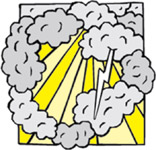

“… Bring my sons from afar and my daughters from the ends of the earth — everyone who is called by my name, whom I created for my glory, whom I formed and made” (Isaiah 43:6 – 7, NIV)It is always interesting to watch people with strong denominational attachments explain their beliefs about creation. I always wonder how long it will take for them to invoke a word or a belief that is not in the Bible or that contradicts what the Bible says. I look for terms that are indicators of following a denominational teaching and not comprehending the real message of the Bible. The
 tragedy is that this
teaching misleads people into thinking that to follow the Bible you
have to accept on faith an interpretation of biblical history in spite
of evidence to the contrary. The fact is that everything the Bible
actually says historically agrees in detail with the evidence.
tragedy is that this
teaching misleads people into thinking that to follow the Bible you
have to accept on faith an interpretation of biblical history in spite
of evidence to the contrary. The fact is that everything the Bible
actually says historically agrees in detail with the evidence. that
in it he had rested from
all his work which God created and made” (Genesis 2:3, KJV). In this
verse the Hebrew words bara
meaning to create and asah meaning to make
are both used. Some translations like the NIV do not treat this as
being two distinct processes, so the NIV says “the work of creating
that he had done.” The fact is that the two words in question are used
in exclusive ways all through the Genesis account. In Genesis 1:1 we
are told that “God created (bara) the heavens and the earth.” In verses
7, 16, 25, and 31 God
made (asah) new things from what He had
previously created. When God speaks of the production of man’s soul in
Genesis 1:27 the word
bara is used. In Genesis 2:7
when man’s body is
described the word used is yatsar
meaning to form or mold. The obvious
implication is that man’s body is being made of material already in
existence and referred to as “the dust of the earth.”
that
in it he had rested from
all his work which God created and made” (Genesis 2:3, KJV). In this
verse the Hebrew words bara
meaning to create and asah meaning to make
are both used. Some translations like the NIV do not treat this as
being two distinct processes, so the NIV says “the work of creating
that he had done.” The fact is that the two words in question are used
in exclusive ways all through the Genesis account. In Genesis 1:1 we
are told that “God created (bara) the heavens and the earth.” In verses
7, 16, 25, and 31 God
made (asah) new things from what He had
previously created. When God speaks of the production of man’s soul in
Genesis 1:27 the word
bara is used. In Genesis 2:7
when man’s body is
described the word used is yatsar
meaning to form or mold. The obvious
implication is that man’s body is being made of material already in
existence and referred to as “the dust of the earth.”| Genesis | Isaiah 43:7 | 1 Thessalonians 5:23 |
|
Man is created in God’s image
(1:27)
bara |
Created
for
glory bara |
Soul psuche |
| Man’s
body
is formed from the dust (2:7) yatsar |
Formed yatsar |
Body soma |
| God
makes life (breath) in man (2:7) asah |
Made asah |
Spirit
(breath) pneuma |
Back to Contents Does God Exist?, MayJun10.